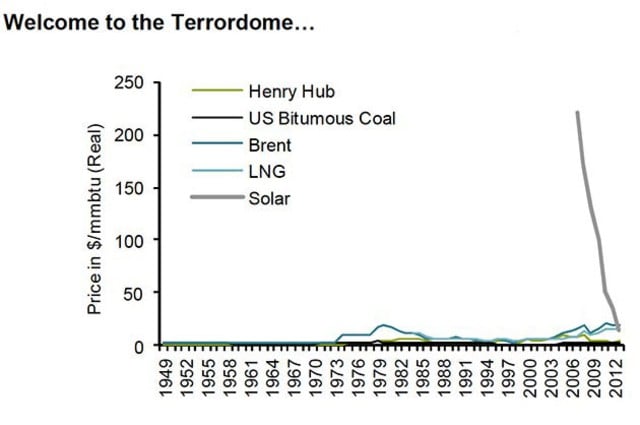
This week, the falling price of oil (and consequently gasoline) took over energy news in many outlets. But there was also news of a certain other energy price coming down. “Solar electricity is on track to be as cheap or cheaper than average electricity-bill prices in 47 U.S. states” by 2016 and all 50 by 2020, wrote Tom Randall in Bloomberg. His article, “While You Were Getting Worked Up Over Oil Prices, This Just Happened to Solar,” cites an analyst report from Deutsche Bank. The report assumes that the U.S. maintains the current investment tax credit, which is set to expire in 2016. Even if the ITC drops from 30 percent to 10 percent, however, 36 states would reach parity. The report also points out that solar is already there in the nation’s top 10 states for solar generation.
There is a compelling reason to expect solar to become increasingly competitive in the energy marketplace, writes Randall: “it’s a technology, not a fuel.” Instead of being supply-limited and subject to price volatility, as fossil fuels are, solar will continue to improve in efficiency and effectiveness, as technologies tend to do. Randall cites a Sanford Bernstein analyst’s Halloween-appropriate term for the “staggering price relationship” between traditional fossil fuels and solar: the Terrordome.
“I’m not sure exactly what that means,” Randall writes, “but it doesn’t sound very forgiving.” (Apparently it’s more than just a Public Enemy song from 1995.)

Two articles in the Washington Post this week dig into how social norms can influence energy choices. In an article entitled “Can we nudge people into conserving energy?” Jim Tankersley discusses behavioral efficiency, or using social pressures to influence consumer demand for energy. Like any good article on behavioral efficiency, it features AEE member Opower, focusing on the company’s pilot program with Efficiency Vermont to use direct calls and peer pressure to reduce summertime peak energy demand. The program worked: Vermont and Southern California, where the program was also running, experienced reductions in demand of up to 5 percent on the hottest days.
“People want to do the right thing, and if it can be made easy for them and made convenient, most people make good choices,” Opower President Alex Laskey said to the Post. “Whether that has a direct economic benefit or not is secondary.”
In another instance of peer influence, Chris Mooney asked and answered the following in the Washington Post: “Why do people put solar on their roofs? Because other people put solar on their roofs.” According to a new study out of Yale and the University of Connecticut, neighbors having already installed rooftop solar was the single biggest indicator of likelihood of additional installations—beating out income and political affiliation. The study found that the installation of a single new rooftop array in a given area “increased the average number of installations within a half mile radius by 0.44,” or almost half. The effect was strictly localized, with much less impact outside of the immediate neighborhood.
So, as you take the kids out trick-or-treating this evening, look up. Is your neighborhood next to enter the Terrordome? (Cue evil laugh…)
Track the Terrordome as neighborhood after neighborhood falls under its inexorable sway... or, you know, energy legislation and regulation through all 50 states using PowerSuite. PowerSuite makes it easy!
Featured image courtesy of NASA and the Solar Dynamics Observatory at Goddard. The "Terrordome" graph is courtesy of Bloomberg and EIA, CIA, World Bank, Bernstein Analysis.
